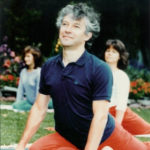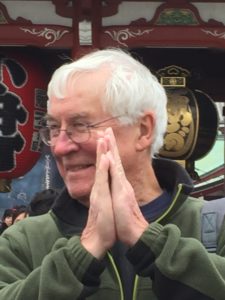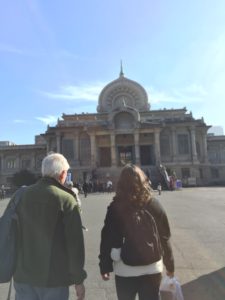The Hindu concept of Sadhana is not something that can be described with absolute precision, because it is often different for each person who experiences it. One definition of Sadhana is given as spiritual practices or disciplines which lead to perfection, these being contemplation, asceticism, worship of a god, and correct living. Not aspiring to perfection or being a big worshipper, I tend to prefer the straightforward Wikipedia take on Sadhana, which is defined simply as: a means of accomplishing something. This means can include practices from a variety of disciplines in Hindu, Buddhist, Jain and Sikh traditions, as well as contemporary psychological and physiological practices that are followed in order to achieve various spiritual or material objectives.

I’ve found that many people–myself included–who have either lived in ashrams, practiced traditional yoga, or embraced a particular spiritual path tend to think of Sadhana as a once per day ritual, generally including yoga and meditation, and usually around 5am and ended at 7am every day of the week. I actually made it every day over the 15 months, except for 4 days when I had the flu and just couldn’t get out of bed.
In looking back, I know that my life changed as a result of this commitment and practice. I became very clear about what mattered to me and what I was wanting to create in my life. My dharma was being slowly revealed to me with each day of practice. Not only was my path apparent, but I also found the courage to walk that path. What I was yet to learn was that much of what I was experiencing would help me create my life’s work – Phoenix Rising Yoga Therapy. During this time, I was personally experiencing the process of change and noticing both the process and the results.
In the years since, I have come to learn that while my Sadhana may include set daily practices, it is also much broader in scope. It can include a practice that applies insight and awareness moment to moment in everyday life. This can encompass every thought, every feeling, every intention, and every action that occurs in my life. The older I get, the more I’ve have appreciated the benefits of this broader day to day living practice along with my morning ritual practice. In this way, my Sadhana and my life are not separate. Life also becomes Sadhana.
To begin one’s own path of Sadhana, it’s best to start with a simple daily ritual practice of yoga, meditation, intention setting, and mindful awareness. Practiced daily, this can have an amazing effect on one’s life. I have also learned that one’s Sadhana is very personal and unique to that individual. You have to learn what works for you. At various stages of my life, my Sadhana has changed and evolved. This involves a process of trial and error but also a process that takes commitment. You can’t know if something works or not until you’ve given it a solid trial over some length of time on a regular basis. When I committed to a year and a quarter of daily practice, I simply followed the prescribed practice and did not question the details – at first. There was no point. I was either committing or not, and if committed, I was signing on for whatever might come as a result. I would engage the practice as it was without the need to change it, fix it, or make it more appealing. It was what it was.
Great intentions at the outset, but, as the year progressed, I was not without complaint. Why can’t we vary the practice? Why the same order and same pace every day? What about a little variety? Frequent conversations with colleagues found support for my complaints. So we complained collectively and requested more variety. The request was denied but a teaching moment occurred instead. We were taught that if we thought it was the same practice every day, we were surely missing something. How could it be the same practice? It was a different day. We were different. Each posture was experienced differently, wasn’t it? Were we not paying enough attention to notice these subtle differences? I’m sure the looks on our faces said it all. WTF? We had to do the same old routine and notice more about it? We had also been taught about surrender so I guess this was another one of those opportunities too! I was there to learn, so I decided to put it to the test despite the internal protest. At first, it seemed like I’d been told to do something that seemed impossible. How could something that was outwardly the same be inwardly different? But I persisted and paid more attention to detail and soon my Sadhana took a leap forward. I was noticing more subtle variations in sensation than ever before. There were slight differences in the way I felt moment to moment and I was noticing. Sadhana was never the same again.
A related lesson that came from this experience was my learning that it helps to follow a set practice for a considerable time – even a prescribed practice – until you have begun to fully appreciate the benefits, form the habit, and become committed. After these are firmly established, you may wish to explore what works best for you in terms of reaching your goals in both your spiritual and material life. However, I would suggest not being in a hurry to rush to modifications. First, fully taste the benefits of a set committed practice. You may ask for how long? I would suggest a minimum of 3 months of the same practice every day, although if you want to try the year and quarter, go for it!

Now, you may think about your daily practice as doing Sadhana. But let me suggest that a true Sadhana is not something you do — or it will likely become very mundane. Instead, Sadhana is something you engage. In other words: it is a process. It is not a checklist of things to do even though it may look like that at first. It will help (and potentially be more effective) if you can engage the process with open enquiry as opposed to simply getting it done. As far as you can, be fully present to each moment and savor the newness of it.

You can design your own Sadhana from scratch if you choose, but I would not recommend that unless you have many years of experience with these kinds of practices. If you have a teacher or a mentor that you work with, it is possible they can help you in designing your Sadhana.
You are also welcome to join me in my practice, which I’ll outline below. There are a few things in setting up a practice that I personally like to take into account.
Bear in mind that practicing regularly and being aware in each moment throughout is more important than the exact nature of the practice itself.
~ I engage my body right from the beginning.
~ I use my body as both a tool for focusing awareness and also as a source of wisdom.
~ I design ways for my practice to integrate to my daily life.
My particular practice relates to and is informed by the Phoenix Rising Eight Themes for meaningful living. (See the Eight Themes outlined in my book Turn Stress Into Bliss).
The edge is also a characteristic of my practice that has informed my life over many years. (See my article on The Edge).
Here is the outline of my current Sadhana practice.
1. Wake Up My Body. If it’s early morning this may include splashing some cold water on my face, jumping around, shaking, stretching, tapping, scratching, or anything that gets the job done to wake it up.
2. Begin with Vigorous Movement coordinated with breath. To get my blood flowing, heart pumping, and breath engaged, I do each of the following movements with much vigor. (These are described in more detail in my book “Turn Stress into Bliss”). Heavy Bucket Swings x10, Bent Over Squats x10, Monkey Side Bends x20 plus side stretch each side, Propeller Arm Rotations x10 forward and x10 back on each arm separately, Swinging Twists x20, Standing Squats x20, Neck Stretch with Arm Pull x3 each side, Vigorous nostril and alternate nostril breathing 2×20.
3. Tune In and Ask. After this warm up I like to come to either a standing or upright back seated position. I close my eyes. I breathe. I place my left hand over the center of my chest. I ask my body this question How do I want to show up in my life today? I wait and listen for the answer. I make sure it comes from my body and not my thinking mind. At first it was difficult to get the distinction but after doing it for a while it became easier and the messages got clearer. Usually the response is just a one or two words. I breathe again and then let it go.
4. Yoga Practice & Meditation. I use the sequence of the 14 postures in the Turn Stress to Book Short 14. Sometimes I engage all of them. Sometimes at least 3 or 4 with longer holding. Towards the end, for at least two of the postures, I deliberately engage Pratyhara – the fifth and often forgotten limb of yoga. Pratyhara is the bridge from asana to meditation. After many years of practice it is not difficult for me to engage Pratyhara but it may take some support if you are new to the concept. A skilled yoga therapist or teacher who is familiar with it should be able to help. For example, a Phoenix Rising Yoga Therapist or Teacher is trained to use skillful a facilitation process to support clients engage Pratyhara. To me, it is the engagement of Pratyhara and the other upper limbs that fuels the depth of my practice and it’s capacity to not just change my life but to transform it.
5. Meditate. At the completion of the sequence, I sit quietly for at least 10 minutes. I begin with watching my breath and become present to each moment. I simply become the witness. Watching. Noticing. Being. I return to the breath whenever I need to refocus on the present moment – here, now. Sometimes I enter a deep meditation after becoming fully concentrated (Dharana) and sometimes my mind is too busy. I’m not concerned about this. I just notice it. Occasionally, I will enter a state of union and bliss and gain profound insight or life changing wisdom (Samadhi). With regular daily practice, this seems to show up when I’m ready and most open to receiving it.
6. Integration. I begin with reflection. What did I notice about myself during this practice? How does it inform my intention for the day ahead? What action steps does it lead me to commit to manifesting? What specifically will I do today as a result?
7. Reconnect and Commit. I place my left hand over the center of my chest. I ask my body once more How do I want to show up in my life today? I take whatever answer I get and come up with at least one action to take this day to manifest that intention in real life. I commit and do it.
Over several years now, I have noticed how this practice has changed and transformed my life in both subtle and profound ways. My life and my relationships have improved as a result and I approach each day with a desire to continue to follow my Dharma.
Michael Lee, MA, Dip. Soc. Sci.,C-IAYT, founded Phoenix Rising Yoga Therapy in 1986. He was the opening keynote presenter at SYTAR in 2016, at Yoga Australia in 2018, and will be speaking at the Japan Yoga Therapy Conference and Global Yoga Consortium in Japan in July 2018. He has some openings for conference bookings in 2019. Contact Yama Talent for more details.


Thank you Michael for sharing your experience and insight in having a daily practice.
Since leaving KRIPALU after 6 years of residency, I have NEVER stopped doing sadhana. I use a headstand device that I do for 15 minutes religiously with meditation. It's a dedication & honoring your inner self, dedicatng it to God for all the great things in my life. Amrit said even do a pose for 5 minutes. I would tell my Bikram students do the cobra for 5 minutes or less. But holding the pose during a tough moment, like keeping the pose past one minute, use it ass a meditation….builds character! But don't be hard on yourself if you have to come down after a few seconds, it's the intention, or as they call BHAKTI yoga.
Beautiful! thank you for sharing your personal experience!
thank you Michael, I affirm and trust in this innate wisdom of our bodies to self-heal and regenerate. Phoenix Rising Yoga practice is a beginning path to awareness and relearning sadhana.
what is my my body feeling or not feeling? what is happening or not happening with my breath? most times I feel myself dancing on the edge of awareness.
Sylvia Colbourne Martin , such nice sentiments and service you give your students. That is sadhana too. Well, really dharma, but depends how you view it while doing it, right? if you would like to have a call to discuss what we offer that might serve your ulitmate goals, best, email me: lori@pryt.com
if you would like to have a call to discuss what we offer that might serve your ulitmate goals, best, email me: lori@pryt.com
Very nice article Michael. Though my personal practice evolved into Qigong after years of yoga, I find these fundamental ideas pertain to all sadhana. Whatever is the language or form these practices provide us with a foundation as well as the thread that is woven into the fabric of our lives. Thank you for stating so well this basic meaning and for giving us such lovely ideas and guidelines. Thank you my brother.
Many thanks for this reflection on sadhana and sharing of your own. Blessed practice!
I agree with Beverly great sharing and love the part of ritual, i wil share with my class today and at some point i will join you and your school to invest a little more of me, which will benefit the people i am blessed to touch.
I love this, Michael. It sounds like a great way to integrate Phoenix Rising into life and keep ourselves personally plugged into the practice (in addition to professional receives, of course.). I especially love hearing about the way you learned to appreciate practicing sadhana from within. It's something I think many of our new students eventually find their way to, and reading this in packet 1 of Level 3 may help them get there sooner. Thanks for posting!